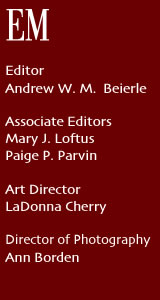Emory
boasts rare literary collections, precious Greek and Egyptian
artifacts, and a wealth of fine architecture, but no major piece
of sculpture–until now.
An anonymous
donor has enabled Emory to buy a sculpture by renowned minimalist
artist Sol LeWitt, the first such significant contemporary sculpture
in the University’s holdings and only the third LeWitt
on view in Atlanta. The piece, recently installed between White
Hall and the Administration building, is a simple tower of white
concrete titled Tower With Vertical Blocks 1.
Associate
Professor of Art History James Meyer says the purchase was some
three years in the making, dating back to the removal of the
Anthony Caro sculpture that had been loaned to Emory during
the Olympics. When the Caro loan expired, the only notable contemporary
sculpture on campus was George Trakas’ Source Route,
a piece of land art in the ravine below the museum.
“Fine
campuses and fine universities usually have examples of public
sculpture, which are very significant for the education of undergraduates
and the university community in the appreciation of art,”
Meyer says. “Atlanta has very few works of public sculpture.
If you are trying to teach art history, you need art to show
students. We basically teach from slides.”
When an
anonymous donor expressed interest in funding a public sculpture
for the University, Meyer, along with art history professor
Clark Poling and Catherine Howett Smith, associate director
of the Carlos Museum, considered several possible contemporary
sculptors, ultimately selecting LeWitt. They explored four works
in his 2002 series Concrete Blocks, settling on Tower
1 because its size and shape were appropriate for the Emory
campus.
Another,
much larger LeWitt piece from the same series is located near
Atlanta’s Freedom Parkway, just a few miles from Emory.
“Now
our students can write papers comparing these two works by the
same artist,” Meyer says. “They’re very different.
Ours is very elegant, while the other is rougher, not as refined.”
Meyer, the
the author of two books on minimalist art, spearheaded the LeWitt
project and walked the Emory campus personally with the artist
to help choose the site for the sculpture. It was erected in
the place formerly occupied by The
Wave, a metal sculpture by artist Jim Clover, which
has been relocated to a spot between White Hall and the Atwood
Chemistry Building.
LeWitt’s
early conceptual work of the 1960s, he says, was part of a movement
that attempted to transcend reference to the real world; but
his later work, including the Concrete Blocks series,
does take on attributes of actual structures such as the ziggurats
and pyramids of Egypt and the ancient Americas. “In this
way the work has a kind of architectural and historical memory,
even though it’s purely abstract at the same time,”
Meyer says.
Meyer hopes
the LeWitt sculpture serves as the foundation for other significant
artworks on campus.
“Emory
deserves this,” he says. “We should have important
art in this place. With the coming of the Schwartz Center, there
has been a drive to bring the arts to a higher level at Emory,
and our understanding will be greater the more resources we
have.
“One
of my students was so excited when the LeWitt was being built
that she went and signed up for the art history major that day.”–P.P.P.





